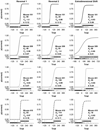Effects of adolescent exposure to methylmercury and d-amphetamine on reversal learning and an extradimensional shift in male mice
- PMID: 28287789
- PMCID: PMC5367946
- DOI: 10.1037/pha0000107
Effects of adolescent exposure to methylmercury and d-amphetamine on reversal learning and an extradimensional shift in male mice
Abstract
Adolescence is associated with the continued maturation of dopamine neurotransmission and is implicated in the etiology of many psychiatric illnesses. Adolescent exposure to neurotoxicants that distort dopamine neurotransmission, such as methylmercury (MeHg), may modify the effects of chronic d-amphetamine (d-AMP) administration on reversal learning and attentional-set shifting. Male C57Bl/6n mice were randomly assigned to two MeHg-exposure groups (0 ppm and 3 ppm) and two d-AMP-exposure groups (saline and 1 mg/kg/day), producing four treatment groups (n = 10-12/group): control, MeHg, d-AMP, and MeHg + d-AMP. MeHg exposure (via drinking water) spanned postnatal days 21-59 (the murine adolescent period), and once daily intraperitoneal injections of d-AMP or saline spanned postnatal days 28-42. As adults, mice were trained on a spatial-discrimination-reversal (SDR) task in which the spatial location of a lever press predicted reinforcement. Following 2 SDRs, a visual-discrimination task (extradimensional shift) was instated in which the presence of a stimulus light above a lever predicted reinforcement. Responding was modeled using a logistic function, which estimated the rate (slope) of a behavioral transition and trials required to complete half a transition (half-max). MeHg, d-AMP, and MeHg + d-AMP exposure increased estimates of half-max on the second reversal. MeHg exposure increased half-max and decreased the slope term following the extradimensional shift, but these effects did not occur following MeHg + d-AMP exposure. MeHg + d-AMP exposure produced more perseverative errors and omissions following a reversal. Adolescent exposure to MeHg can modify the behavioral effects of chronic d-AMP administration. (PsycINFO Database Record
(c) 2017 APA, all rights reserved).
Conflict of interest statement
The authors declare no conflicts of interest.
Figures





Similar articles
-
d-Amphetamine and methylmercury exposure during adolescence alters sensitivity to monoamine uptake inhibitors in adult mice.Neurotoxicology. 2019 May;72:61-73. doi: 10.1016/j.neuro.2019.02.001. Epub 2019 Feb 12. Neurotoxicology. 2019. PMID: 30769003 Free PMC article.
-
Gestational exposure to methylmercury and selenium: effects on a spatial discrimination reversal in adulthood.Neurotoxicology. 2006 Sep;27(5):721-32. doi: 10.1016/j.neuro.2006.03.022. Epub 2006 Apr 15. Neurotoxicology. 2006. PMID: 16759706 Free PMC article.
-
Adolescent methylmercury exposure: Behavioral mechanisms and effects of sodium butyrate in mice.Neurotoxicology. 2019 Jan;70:33-40. doi: 10.1016/j.neuro.2018.10.011. Epub 2018 Oct 29. Neurotoxicology. 2019. PMID: 30385387 Free PMC article.
-
Methylmercury and nutrition: adult effects of fetal exposure in experimental models.Neurotoxicology. 2008 Sep;29(5):783-801. doi: 10.1016/j.neuro.2008.06.007. Epub 2008 Jul 5. Neurotoxicology. 2008. PMID: 18652843 Free PMC article. Review.
-
A hypothesis about how early developmental methylmercury exposure disrupts behavior in adulthood.Behav Processes. 2015 May;114:41-51. doi: 10.1016/j.beproc.2015.03.007. Epub 2015 Mar 17. Behav Processes. 2015. PMID: 25795099 Free PMC article. Review.
Cited by
-
A Systematic Review on the Influences of Neurotoxicological Xenobiotic Compounds on Inhibitory Control.Front Behav Neurosci. 2019 Jul 4;13:139. doi: 10.3389/fnbeh.2019.00139. eCollection 2019. Front Behav Neurosci. 2019. PMID: 31333425 Free PMC article.
-
DCC-related developmental effects of abused- versus therapeutic-like amphetamine doses in adolescence.Addict Biol. 2020 Jul;25(4):e12791. doi: 10.1111/adb.12791. Epub 2019 Jun 13. Addict Biol. 2020. PMID: 31192517 Free PMC article.
-
d-Amphetamine and methylmercury exposure during adolescence alters sensitivity to monoamine uptake inhibitors in adult mice.Neurotoxicology. 2019 May;72:61-73. doi: 10.1016/j.neuro.2019.02.001. Epub 2019 Feb 12. Neurotoxicology. 2019. PMID: 30769003 Free PMC article.
-
AMPed-up adolescents: The role of age in the abuse of amphetamines and its consequences on cognition and prefrontal cortex development.Pharmacol Biochem Behav. 2020 Nov;198:173016. doi: 10.1016/j.pbb.2020.173016. Epub 2020 Aug 20. Pharmacol Biochem Behav. 2020. PMID: 32828971 Free PMC article. Review.
-
D-serine reduces memory impairment and neuronal damage induced by chronic lead exposure.Neural Regen Res. 2021 May;16(5):836-841. doi: 10.4103/1673-5374.297086. Neural Regen Res. 2021. PMID: 33229717 Free PMC article.
References
-
- Adriani W, Macrì S, Pacifici R, Laviola G. Peculiar vulnerability to nicotine oral self-administration in mice during early adolescence. Neuropsychopharmacology. 2002;27(2):212–224. - PubMed
-
- Andersen SL. Trajectories of brain development: Point of vulnerability or window of opportunity? Neuroscience and Biobehavioral Reviews. 2003;27(1–2):3–18. http://doi.org/10.1016/S0149-7634(03)00005-8. - DOI - PubMed
-
- Andersen SL, Rutstein M, Benzo JM, Hostetter JC, Teicher MH. Sex differences in dopamine receptor overproduction and elimination. Neuroreport. 1997;8(6):1495–1498. http://doi.org/10.1097/00001756-199704140-00034. - DOI - PubMed
-
- Andersen SL, Thompson A, Rutstein M, Hostetter J, Teicher M. Dopamine receptor pruning in prefrontal cortex during the periadolescent period in rats. Synapse. 2000;37(2):167–169. http://doi.org/10.1002/1098-2396(200008)37:2<167::AID-SYN11>3.0.CO;2-B. - DOI - PubMed
-
- Arnsten AFT, Rubia K. Neurobiological circuits regulating attention, cognitive control, motivation, and emotion: Disruptions in neurodevelopmental psychiatric disorders. Journal of the American Academy of Child and Adolescent Psychiatry. 2012;51(4):356–367. http://doi.org/10.1016/j.jaac.2012.01.008. - DOI - PubMed
MeSH terms
Substances
Grants and funding
LinkOut - more resources
Full Text Sources
Other Literature Sources
Research Materials
Miscellaneous

